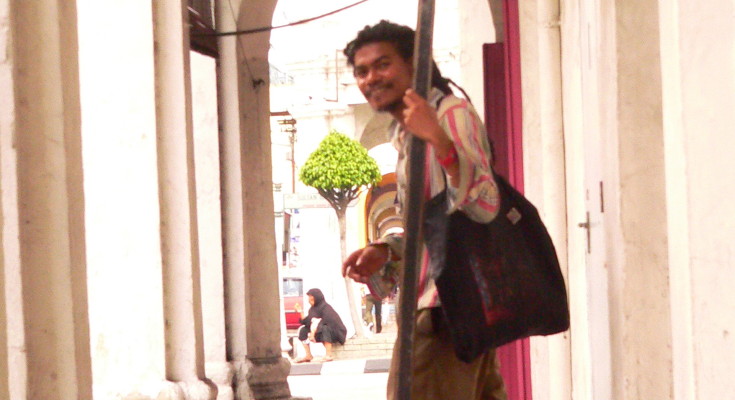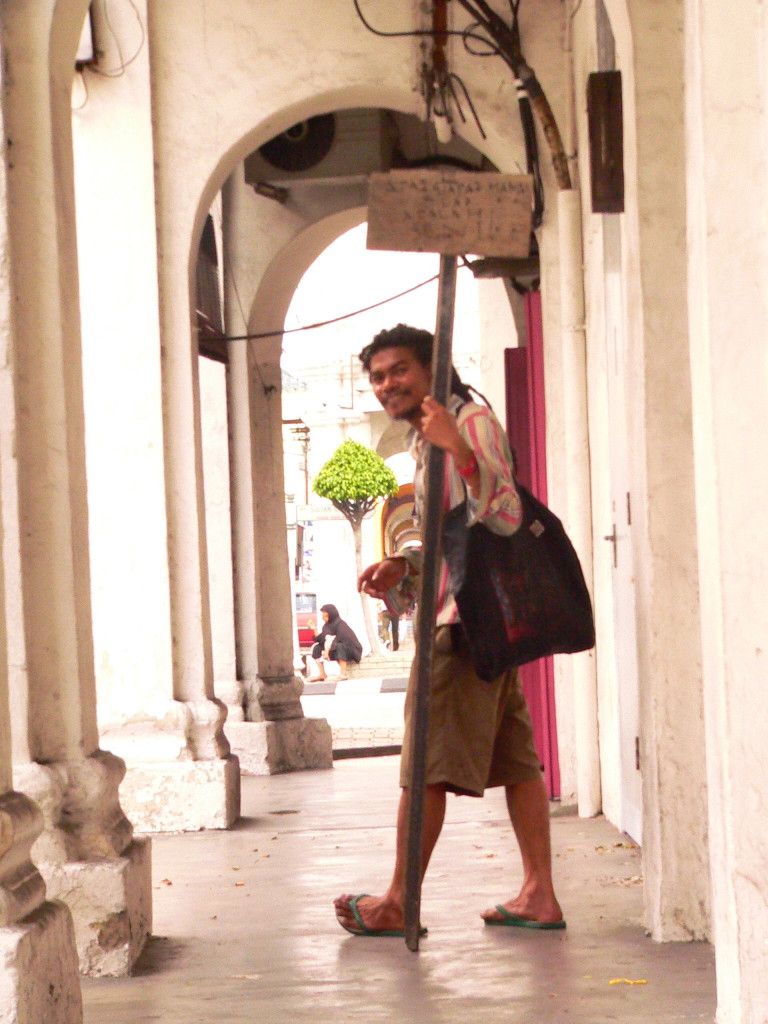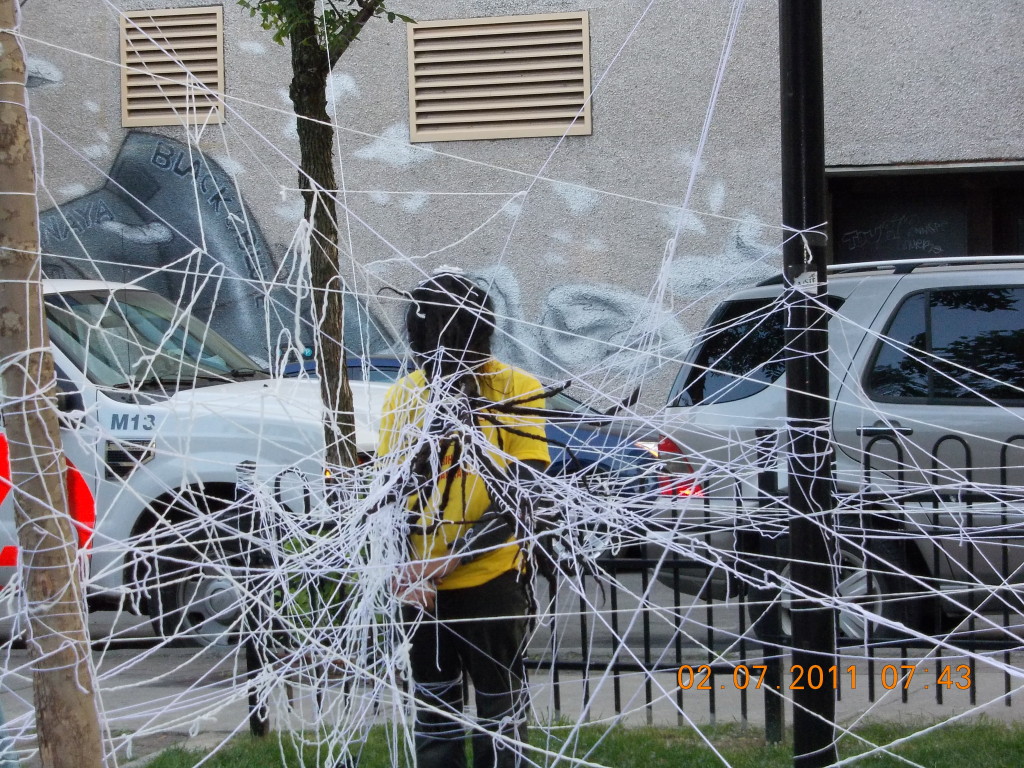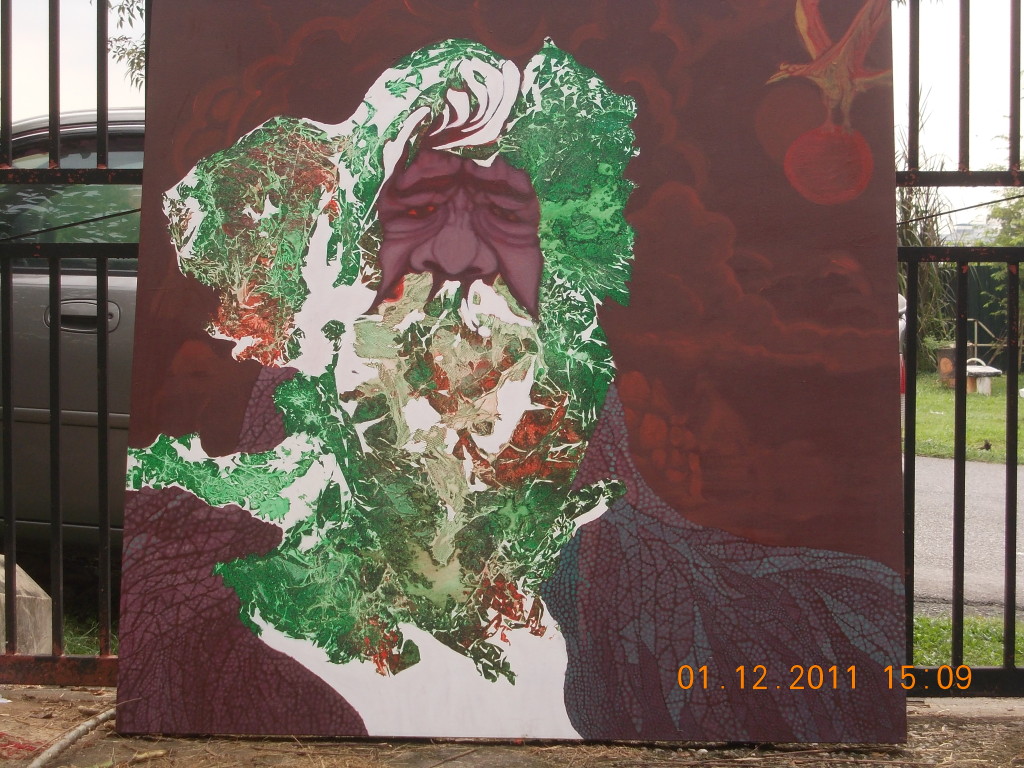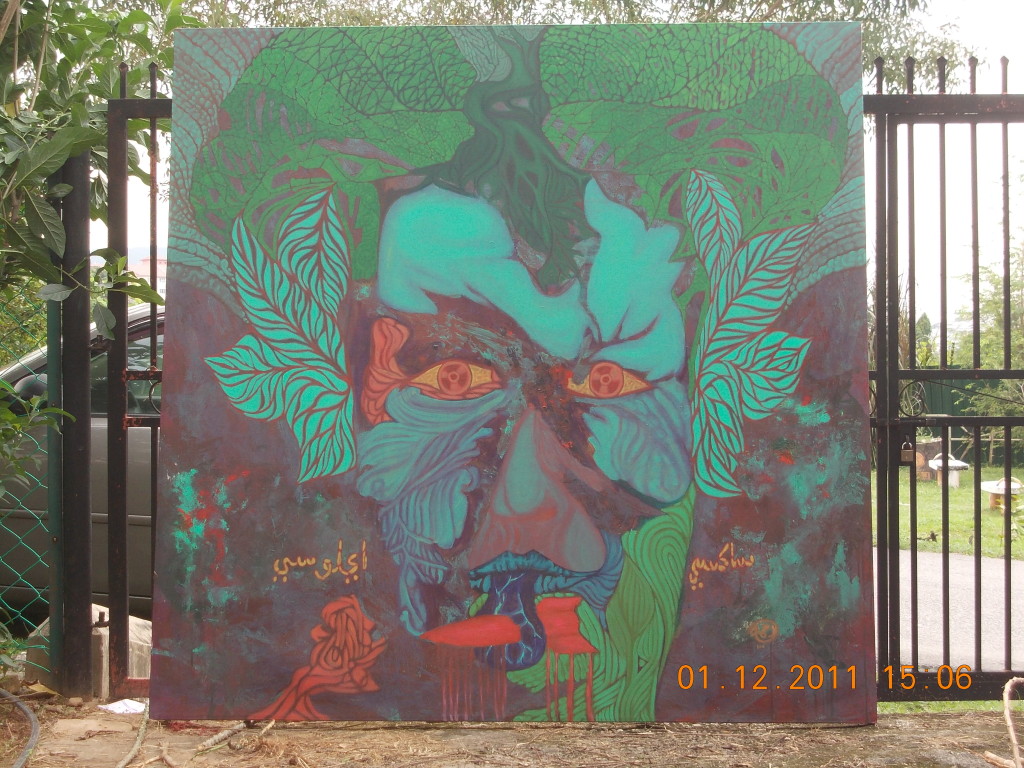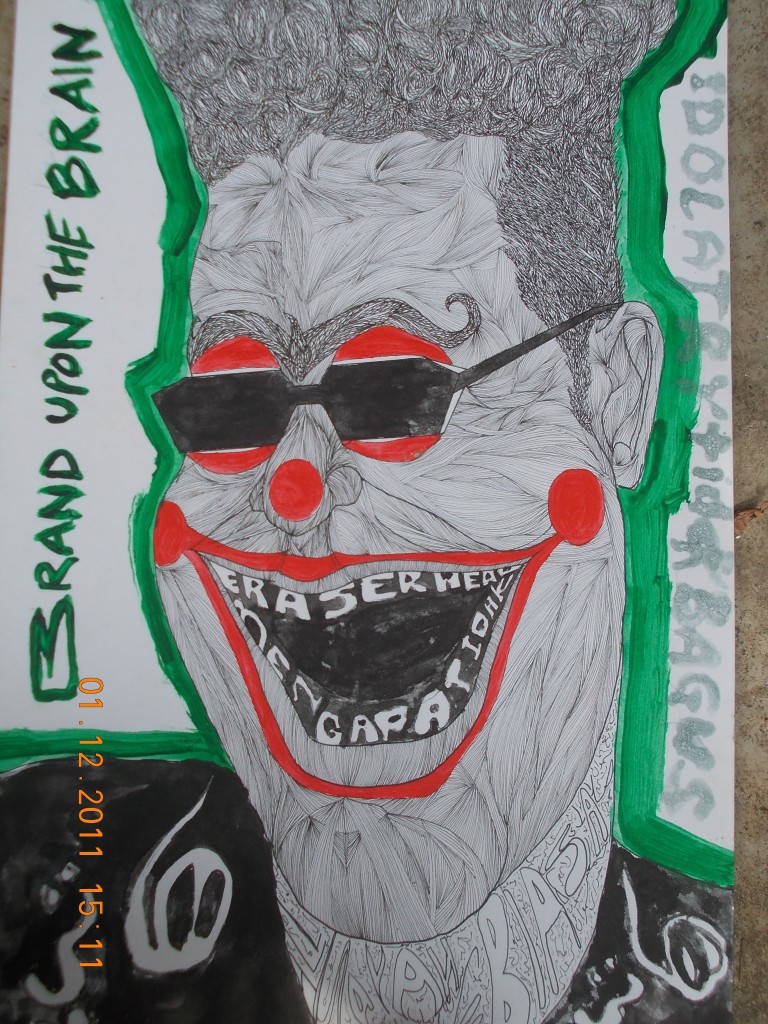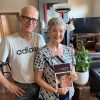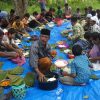By: Melissa Lin
There are currents of powerful reflection, thought and emotion in the work of Malaysian artist Rahmat Haron. Whether it is through the medium of his poetry, drawings, paintings or performances, his works convey a reflection of his life and experiences – in Malaysia – where he considers the social and the political realities, the limitations inherent to a ‘strong state and societal values’, the need for change, and his own need for self expression.
More than that, his works are thought provoking, inspiring and encouraging to those who are finding or paving their own new and original ways of being and expression, and disturbing to some who would prefer to cling to the status quo.
Rahmat says of himself, “I am a professional drifter, a super poseur, a fake quasi wanderer and a wannabe of too many things. I am still studying in universe, majoring on life.”
His blog can be found at http://sampahseni.blogspot.com/
Hi Rahmat, firstly, maybe a self introduction to the Latitudes readers. You wear many hats as an activist, poet, writer, visual and performance artist. Can you tell us about how you personally see your creative and artistic practice, is there a common thread, theme or focus that runs throughout what you do?
Well I used to be in a frontline human rights/ civil rights activism. But that were things of the past. Since post March 2008, or precisely maybe since 2010, I’m no longer an activist. I still support activism, but I must stress I’m no longer an activist, in the sense of what I used to be.
I think the common thread maybe about the concept of individuality, is a consciousness about what am I and how I live. My art often deals with social interaction and compromise in regards to individual problems, conflicts and the complex psychologies that come into play, well particularly of myself. Conflicts of placement –or displacement – of an individual in dealing with the state, society and institution. While the themes of my works vary from one another, the core remains the same, the concept of freedom of expression. A basic theme, lame maybe to western society, but for a society like Malaysia, where the state and the societal values are so strong, at least to me it is very important.
Your youth was spent studying economics, and you later became disillusioned with the education system in Malaysia, spending your time being involved in activism. Can you tell us about how that period shaped your life, and about the community art and theater projects you were involved in at that time with the activist initiated Universiti Bangsar Utama?
It taught me to be independent, to know that change is permanent, it shaped my understanding about the society and the state that I live in. And it developed my interest in art. At the very beginning it just showed how art can be a critical means for our propaganda.
Looking at it now, I would say what we did was not much or maybe even a little bit lame. However it seems that we were the only group at that time that ventured into so called radical cultural politics and youth activism. Our director, Hishamudin Rais spent 2 years in prison, without trial because of that theater. Another activist just spent 25 days in jail, but it broke him for at least 1 year, our University was closed down temporarily, but reopened again, we just keep on fighting, and didn’t care much about state intimidation.
I would say Hishamudin Rais is very important in opening our eyes to the world. Being the only adult in our group, the UBU was his idea, and we were just the crew. He had been a student activist from the 70s, spent his life in exile for 20 years, came back became a film director, but hadn’t had a chance to see his first (and for a time being only) film released, due to a famous political saga of that time. It involved Mahathir sacking his deputy prime minister, Anwar Ibrahim in September 1998, and the shame trial.
We were busy demonstrating every week, and touring Malaysia, with our satirical theater. That was memorable and unforgettable.
It is perhaps a deep and long history of how Malaysia has shifted politically, and artistically from the time of Universiti Bangsar Utama from the late 90’s and early 00’s to now. What were your ideals and hopes then, and have they changed or evolved much?
Things are evolving but not up to my ideal yet. For example we get rid of Mahathir as a prime minister after his tenure 23 years in power. However, he understands the people’s sentiment and resorted to a tactical resignation, and until now he is still behind the powers that be. Of course there are other dynamics in his party now, but I don’t care. We are still rule under the same ruling party for 54 years.
We still don’t have an independent judiciary, no free and fair election, no free media, all the print and electronic media are owned by the cronies related to the ruling party, corruption and mismanagement of public funds are rampant, no basic rights, even not what was written in our constitution, not to say the international human rights standard that is still a dream. Our country is not a signatory of the International Civil and Political Rights Covenant or of the Convention against Torture. Racial and religious conservatism are still the integral part of our politics.
And now the government is putting up a bill in parliament called the Peaceful Assembly Law, which should be called the Illegal Assembly Law. It’s even worse than the Burma Military Junta Illegal Assembly Law. For example in Burma you need to inform the police 5 days before a demonstration, but here in Malaysia, under this new law, you need to inform the police 30 days prior to an assembly. Street protest and demonstrations are not allowed. So you’re allowed to demonstrate or to have a protest but only in a hall or in a stadium.
We have new media, internet, which is a very powerful tools for change. Even though the digital divide is still very wide, and there are calls by the ruling party to regulate and control internet, and that’s alarming.
But on a brighter side of it, change is inevitable. For example, during the street demonstration in 1998, it was just a plain gathering of angry people with oratory speeches and sloganeering. There’s no color to it. No songs, no art. Now we have many kind of beautiful artistic expression during protest. People becoming more and more creative in their political expression. Like in Kuantan recently, where people protested against the rare earth radiation refinery factory, thousands of people came out and smash hundreds of pinata. More artists involve in a movement for democracy, more expression, more art, more songs, more poetry and literature that advocate change. I would says hundreds of artists are involved now.
How do you see the current political situation in Malaysia, and how does that inform the works you are engaged in now?
It doesn’t change the political situation in Malaysia much, as I was describing earlier. But is no where compared to Mahathir’s authoritarian iron fist. But that was not due to the government wanting reforms, but because the state knew that more and more people are speaking up. So the game now is not disinformation but misinformation. Like we have this Movement for Free and Fair election called Bersih (clean) last July. Prior to that demonstration, there were arrests of political activist without trial. Some were arrested simply because they wore yellow shirts (the official color of the movement). Every day you see threats and intimidations in mainstream media. Like right wing groups threatening with racial riots etc. People just defied that, on July 9th hundreds of thousands people took to the street. On that day itself more than 1,500 people were arrested.
What is art to you?
I need to write a book about this. Hahahha. Again art for me is simply freedom of expression. Be it conceptual, post modern, surreal, dada or situationist. Object, non object. Literature or visual art. What is art, it seems to be very basic question, but this question makes what we see art today. A profound question that always seeks an answer that has never been absolute. A question that even I keep on asking myself, until now I can’t have a definite answer.
What do you hope to impress upon people with your writing, your performances and your art?
When I do my art, I don’t have any intentions to impress people whatsoever. But if my art can inspire other people, in a smallest way, that’s already enough.
Who have been some of the major influences, how have they impacted your life and work?
There’re too many of them. People that I know, first of all my mother, a single mother who raised ten children – I’m the youngest – as a factory worker. All of my friends from the underground music scene – be it metal, punk, post punk, indie, folk etc. The UBU Chancellor’s Hishamudin Rais. Our people laurette, come Bersih Icon, A. Samad Said. The Malaysian post modernist artist of the 90’s, Nur Hanim Khairudin, Wong Hoy Cheong, Hasnol Jamal Saidon, Ise.
International art and literary figures, such as Indonesia’s Pramoedya Ananta Toer, the Taring Padi art collective in Jogjakarta, the Panic Movement of the 60s – Alenjandro Jodorowsky, Fernando Arabal, Roland Topor, the dadaist, the surrealist, Fluxus, the situationist movement and not to forget singer-songwriter Leonard Cohen.
Their spirit, determination and imagination, to continue to believe in whatever things that they’re doing despite constraint and challenges. That had a great impact on me to follow their path, as Rober Frost said it, is a road less travelled.
In the past years you have been doing performance art. We have had conversations about this, paraphrasing you, would it be correct to say that you view performance art as a more immediate, visceral and even ‘pure’ expression of art? Can you tell us about your thoughts and experiences of being a performance artist?
Pure in a sense that it is not yet commodified. Hahaha. I think my views of performance art also changed throughout these years. For me, now, performance art is something between conceptual art and poetry. Performance art involves ideas of using the body for creating images, or experience that are transient, unlike object art, which is meant to last forever.
Being a performance artist in Malaysia is always being misunderstood, like you’re considered a freak, unique, eccentric or your works are seen as an abstract form of art. And that is a challenge to me, not to subscribe or to make them understand, but to continue doing it. Because you can’t survive financially by doing performance art. And to tell them, performance art is not exactly about finding meaning, there are millions of things in this world that you don’t know the meaning of or you can’t understand, but you still experience or feel it.
As a performance artist you have been invited to participate in several international performance art festivals. To date, what has been your favorite performance and in which country? Do you have some stories to share about your art and travels?
I think I like all the festivals that I have participated in. I mean festivals in a real sense, like punk gigs, like a party, rock n roll, with lots of talking, discussions, not in a formal way.
I like the Beyond Pressure Festival that I participated in, in Burma, in 2009. Knowing Burma’s situation, I came out with a performance exploring the body as a live sculpture or live installation. I did my “Connection and Disconnection series” where I asked the audience to attach cotton ropes with my body to anywhere they wish, then at the end of my performance I cut the ropes. After the performance many people came to me, and explained to me how they interpreted my performance with regards to Burma’s situation of isolation and political suppression. That was bigger than I thought.
In Montreal, Canada there was one girl following the entire 7 hours performance I did, the same series of Connection and Disconnection, where I stand still while the audience connects the ropes to my body. After the performance I still saw the girl. I thought she was sketching, I had some people doing life drawings during my performance in the past. But surprisingly, she was writing poetry about my performance, and that was sweet.
In Jatiwangi, Indonesia, I was inviting the community to clean up the cemetery. One morning before the performance, while we were having breakfast in the house that I stayed at, there was an accident. A gas tank almost exploded. The was fire in a kitchen. But fortunately, we were saved by a brave guy from the house who was very fast in taking all the immediate action to stop the fire from spreading. If my performance was titled, “Picnic in cemetery with Rahmat Haron” it would now be the funeral of Rahmat Haron.
What kind of advice would you give to younger artists or activists starting out?
Hey, I am not that old, am only 34. I’m not sure that I am in a right position to give advice to young people, since I thought I am the one who needs advice from them. Knowing young people they don’t like other people to give them advice. The youth knows the world that they’re living now better, what they want or how to do it. Maybe a cliché line, keep up the good spirit, salute! And please do not be the youth of Pol Pot.
This is one of Rahmat Haron’s poems, titled THE HANGING BABEL
(i)
The last breathe of the beginning
Its begins at the end
It culminates at the beginning
(ii)
My kamarade is my garden
Dangling like the Tower of Babel
Untouched by mother earth
Oh yea
My hanging garden
Decaying within the crevice of rocky stones
A carpet of mould
Fungus and muddy dust
Dark city
Pilloried by spiky steel bars
Archaic building
It torn my heart with unspoken promises
Dangling
Beneath my beautiful garden
A mountain of decaying garbage
Wrecking my soul
Draining my bitter visage
Alone,
Oh yeah, my garden is in illusionary dream
Chilling my eyes arousing hope
Green is my deep view
Crystallising my desire
Screeching irritating noises
Knocking, banging, stepping, hitting,
Seeping, touching and calling
I am listening to the sound of silence
Solitude accompanied my mute garden
Illusionary
In the casserole,
Watered by piping fluoride, manure by excess rubbish, washed by man
made
rain
And
Breathing toxic
Inhaling cancerous carbon monoxide
Objects, machines, engines
Strangled my garden
Cornered into a mute box
(iii)
From the Black Hole to Genesis
It appeared
Then it disappeared
Julai-sept 2005
Bangsar utama, kl.

